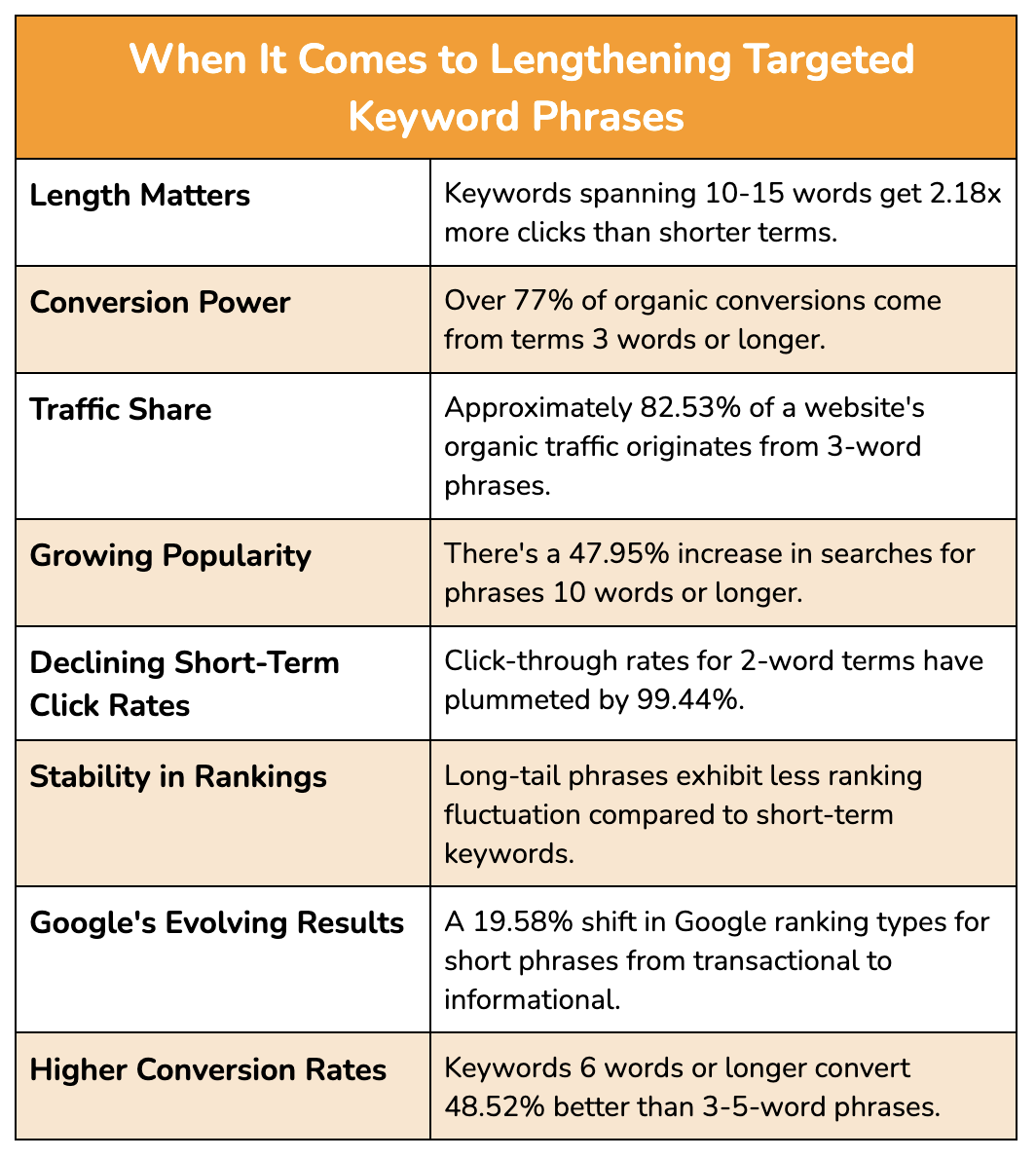Why Long Tail Keywords Are Important for SEO in 2025
This post is all about long tail keywords.
If you’ve been knocking your head against the wall, trying to suss out if long tail keywords are still useful for SEO in 2025, then you’ve come to the right place.
SEO is getting tougher, and it’s forcing marketers to find even more clever ways to build relevancy and presence in an online space flooded with AI-generated content. To that end, we’re noticing distinct patterns surrounding SEO keyword strategy as we enter 2025 — and one of them is the growing importance of long-tail keywords.
In this article, we’ll walk you through exactly why long tail keywords are important for SEO success.
TABLE OF CONTENTS:
Why Long Tail Keywords?
Long-tail keywords are phrases typically longer than three words, more specific, and less competitive than generic keywords. Analyses by Neil Patel on why long-tail keywords are important for SEO:
What kind of keywords should you really be targeting with your SEO?
We decided to look at our database of 7.4 billion keywords and match it up to analytical data we have on over 1 million plus websites, to figure out what type of keywords are the best.
Because there are head…
— Neil Patel (@neilpatel)
Using tools like UberSuggest and Answer the Public, this analysis revealed some powerful truths about the digital climate that SEOs are facing when it comes to lengthening their targeted keyword phrases:

How Long Tail Keywords Are Gaining Traction
1) Enhanced User Intent Matching
Long-tail keywords excel in aligning with specific user intents, which significantly improves the chances of matching a searcher’s exact needs. This precision not only increases relevance but also leads to significantly higher conversion rates.

For example, a user searching for “best lightweight waterproof hiking boots for women” is likely in the final stages (commercial or transactional) of the buying process, seeking a product that meets very specific criteria. In contrast, a general search for “hiking boots” may indicate that the user is still in the information-gathering phase (informational).
Think of it this way: When content creators and marketers focus on long-tail keywords, they will inevitably hone in on highly focused content that speaks directly to the user’s stage in the buyer’s journey, increasing the likelihood of engagement and conversion.
When you niche down the topics you write about, people will get more value from it since you took the time to delve deeper into a subject.
2) Less Competitive, More Opportunity
Long-tail keywords, being less common and highly specific, inherently face less competition. Although the search volume might be less than you’d like, the reduced competition is helpful for websites, particularly for niche markets or specialized topics, as it offers a higher chance of ranking on search engines.

For instance, a small business specializing in handmade, eco-friendly pet toys could target long tail keywords like “handmade organic dog toys for large breeds,” which likely have lower competition than broader terms like “dog toys.” This strategy allows smaller or more focused businesses to compete effectively against larger competitors, carving out a significant presence in specific niches.
In essence, long-tail keywords level the playing field, providing opportunities for targeted visibility amongst all the hustle to rank for a few terms that most users are searching for.
Instead of chasing those few, highly-searched terms, brands will likely find more luck pursuing a wider range of more niche terms.
These niche terms, on their own, might carry a small amount of search traffic, but when all combined, will drive the volume to make up for the really competitive broader terms.
3) Changing Search Patterns
With how much voice search technology and conversational AI platforms like ChatGPT has adjusted otherwise normal search patterns, users are adopting a more conversational tone in their queries, asking longer, more detailed questions as they would in natural speech.
The use of voice technology like digital voice assistants is also steadily increasing from year to year (with around 8.4 billion in 2024), which is no surprise when we factor AI into the equation:

This shift in behavior ultimately points toward long-tail keywords, as they often mirror the structure of these conversational queries.
For example, a voice search query might be “What are the best energy-efficient home appliances for a small apartment?” which is much more specific and detailed compared to a traditional search like “energy-efficient appliances.”
As search technology continues to get more refined and become more integrated into everyday life, the importance of optimizing for long-tail, conversational queries will only ramp up, making them a crucial element of modern SEO strategies.
4) Focus on Quality Traffic, Not Just Quantity
It’s crucial to focus on traffic that leads to conversions. While high-traffic keywords are attractive, they often don’t translate to tangible business outcomes.
Long-tail keywords, although attracting fewer searches, bring in more qualified and conversion-ready visitors.
For example, a website featuring specialized photography equipment will benefit more from targeting long-tail keywords like “best mirrorless cameras for wildlife photography” rather than a high-traffic, generic term like “cameras.” This approach supports the logic that traffic driven to the website may be fewer and farther between, but is highly relevant, qualified users that are more likely to convert into a sale or complete a desired action.
In the end, long-tail keywords offer a more sustainable and effective approach to driving meaningful traffic that aligns with your business goals.
Our Current Approach to Long Tail Keywords
Alright, it’s time we put our money where our mouth is. Below is the general structure we follow as to why long-tail keywords are important for SEO:
- Content Tailoring: Develop content that specifically addresses long-tail queries. For example, a blog post titled “How to Optimize Your CTR for Different Search Intents” targets a specific audience more effectively than a generic “Search Intents” post.
- Understanding User Needs: Analyzing search trends and user behavior helps in crafting content that resonates with the audience’s specific needs and questions. Tools like Google Analytics and keyword planners are invaluable for this purpose.
- Balancing Keyword Strategy: While focusing on long-tail keywords, it’s crucial not to ignore broader terms. A balanced approach ensures coverage across various stages of the customer journey.
- Technical Optimization: Ensure that your website is technically optimized for SEO. This includes aspects like site speed, mobile-friendliness, and structured data, which help search engines understand and rank content effectively.
Final Thoughts on Why Long Tail Keywords Are Still Important for SEO
The importance of long-tail keywords in SEO is undeniable. We simply can’t ignore it as a viable alternative to highly competitive industry terms that everyone is gunning for. Long-tail keywords offer targeted traffic, higher conversion rates, and less competition, albeit lower search volume. But that’s what we have to learn to let go of — the fixation on chasing search volume over search quality.
As search engines and user behaviors evolve, adapting keyword strategies to include more specific, long-tail phrases becomes not just beneficial, but essential for SEO success.
From my perspective, incorporating long-tail keywords into your SEO strategy will move the needle, leading to improved rankings, more qualified traffic and, ultimately, better conversion rates.
If you’re ready to drive measurable increases in organic traffic with strategic optimization, Single Grain’s SEO experts can help!👇
Frequently Asked Questions About Long Tail Keywords
-
What are long tail keywords for SEO, and why do they still matter in 2024?
Yes—long tail keywords for SEO still matter in 2024 because they align tightly with search intent, lifting conversion rate while lowering keyword difficulty. They mirror conversational queries from voice search and map cleanly to stages of the buyer’s journey. Even with lower search volume, the traffic is highly qualified, boosting organic traffic efficiently. In essence: fewer visitors, better matches, stronger outcomes.
-
How do I build a long-tail keyword strategy that actually moves the needle?
Build a long-tail keyword strategy by mapping topics to the buyer’s journey, then clustering pages around specific questions and use cases. Prioritize terms with clear intent and manageable keyword difficulty, not just search volume. Optimize technically – fast pages, mobile-first, and structured data markup. Interlink clusters with a hub page. Done right, this balance will move the needle faster than chasing broad head terms.
-
How do I find long-tail keywords fast without sacrificing relevance?
Start with seed topics, then find long-tail keywords using AnswerThePublic, Ubersuggest, and Google Keyword Planner. Pull real queries from Search Console and People Also Ask. Filter for intent fit, low difficulty, and enough search volume to matter. Group related phrases into content clusters so each page nails one problem with high content relevance. That’s quick, practical, and repeatable.
-
Are long tail keywords less competitive, and does that mean easier rankings?
Generally, yes—long tail keywords are less competitive, so rankings are easier relative to broad terms. But they still rely on core ranking factors: content relevance, topical depth, internal links, and clean on-page SEO. Target specific problems, answer them directly, and you’ll earn traction even in crowded niches. It’s niche marketing 101, and it works.
-
Do long tail keywords improve conversion rate compared to broad terms?
Absolutely. Long tail keywords tend to lift conversion rate because they signal commercial or transactional intent. Someone searching ‘best lightweight waterproof hiking boots for women’ is farther along the buyer’s journey than ‘hiking boots.’ You’ll trade some search volume for qualified clicks and more sales or sign-ups, which is the win that actually matters.
-
How should I optimize for voice search with long tail keywords in 2024?
Optimize for voice search with long tail keywords in 2024 by writing in natural, conversational language and structuring content as clear Q&A. Use question-style H2s, concise answers, and FAQPage structured data markup. Target local and ‘near me’ variations when relevant. Fast, mobile-friendly pages help too. We’re noticing distinct patterns here: sound like a person, and you’ll win the query.
-
What's a smart balance between long tail keywords and head terms in an SEO plan?
Balance looks like this: use head terms for reach and authority, and long tail keywords to capture high-intent clicks. Plan clusters where a broad hub builds awareness while supporting pages tackle specific, lower-difficulty queries. Don’t chase search volume alone—match search intent across the funnel. In essence, breadth earns visibility; specificity converts.
-
What are the benefits of long-tail keywords for niche marketing and small sites?
The benefits of long-tail keywords for niche marketing are big: lower keyword difficulty, faster rankings, and traffic that’s primed to act. Small sites can outmaneuver giants by answering precise questions with laser-focused content relevance. Stack dozens of modest-volume pages and the organic traffic compounds. That’s how smaller budgets still put points on the board.
-
How do I measure the success of a long-tail keywords strategy over time?
Measure a long-tail keywords strategy by tracking rankings for target phrases, organic traffic to each cluster, click-through rate, and, most importantly, conversion rate. Use Google Search Console for queries and impressions, and Google Analytics for goal completions. If pages match search intent but don’t convert, refine offers and CTAs. Want help? Get My Free SEO Plan.
-
How often should I refresh my long tail keywords 2024 research and content?
Refresh long tail keywords 2024 research quarterly—or sooner if SERPs shift or new conversational queries emerge. Watch Search Console for rising terms, compare intent on page to intent in query, and update titles, FAQs, and examples. When patterns change, adapt fast. That cadence keeps content relevance high and rankings stable.
Related Video
For more insights and lessons about marketing, check out our Marketing School podcast on YouTube.





